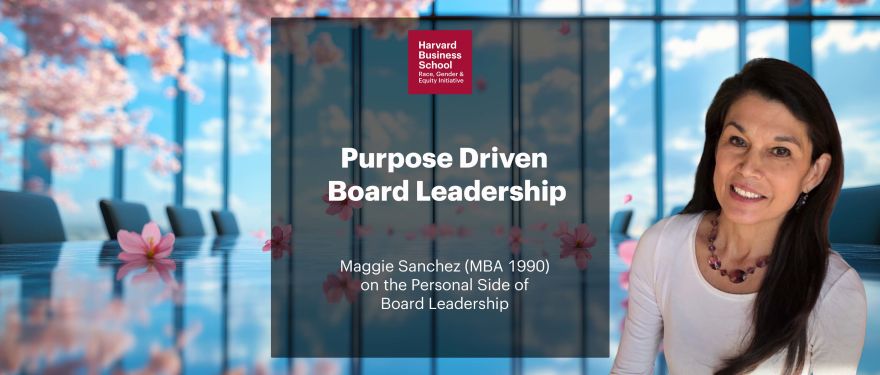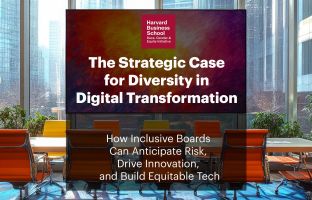Getting to the Boardroom
There’s an immediate warmth one feels while in conversation with Maggie Sanchez (MBA 1990). Sanchez’s home office is in sunny Arizona, but more than anything else, her ability to build strong relationships shines through. Even via Zoom, she can quickly connect on a human level and create space for thoughtful conversation.
Over her 35-year career, Sanchez has a track record of successfully scaling large businesses, navigating digital transformations, and building thriving partner ecosystems. Specializing in marketing, strategy, and business development, her experience spans global enterprises, digital startups, nonprofits, and higher education. Today, she is the Founder and CEO of Digital Impact, an innovation, entrepreneurship, and leadership consultancy. When asked about her journey to board service, she’s clear and intentional: “I always knew I’d be on corporate boards. From the outset, I had it as an ambition that I’d join a public board, so I took advantage of opportunities in corporate America to learn and grow, lead committees, and get out of my comfort zone.”
This openness to learning is likely why Sanchez has had such a varied career in and outside of corporate America. Skilled at managing complex, multi-stakeholder organizations and building partnerships, Sanchez has led change initiatives inside companies including IBM, 3M, Tektronix, Microsoft, and Vodafone. Sanchez’s work with Microsoft, for example, took her to Paris to lead the company’s transition to the cloud. She joined Vodafone at its headquarters in the UK shortly after the company had acquired a variety of telecom companies throughout Europe and needed to unify teams around shared values and enterprise growth in the new world of fixed-line broadband and mobile convergence, and IoT networks. During her time in the corporate world, she also discovered a passion for entrepreneurship—building diverse ecosystems of innovators that “cultivate leaders and innovators who shape our world”. Now, she’s even more focused on giving back by helping boards embrace change.
Before joining a corporate board, Sanchez was on 11 advisory boards of technology startups and served on the Rio 2016 Olympics and Paralympics nonprofit board. This way, by the time public board service became a possibility, she could demonstrate how she’d effectively guided other entities. From there, it was a matter of communicating her skills and knowledge. Boards used to look for directors with functional expertise in one industry, she says, but today they want candidates with a much wider range of experiences. “You have to bring in some domain expertise, but the more you’ve been able to apply your knowledge and learn across a vast array of sectors, the more attractive you become.”
After another director referred her to the Republic Bank of Arizona board, it was her tech and cross-industry skills that made her stand out, particularly in digital transformation. It helped that Sanchez was open to an opportunity that she didn’t see coming. She didn’t have direct experience with serving on a bank’s board but she knew the value of her skills and that she could research what she didn’t already know. “There’s a quote I love,” Sanchez says: “‘When someone says yes to you, don’t say no!’”
Navigating Leadership Challenges
Sanchez reminds aspiring directors that board leadership is about curiosity and asking, “Where’s the future?” Whether it’s understanding customers or how to stay competitive, this is where her rich experience comes in and where she knows other leaders, especially women, have much to offer. Sometimes women are hesitant to put themselves forward because they don’t think they have the right background, she says. “But I’ve always raised my hand for the most difficult thing. Even if I didn’t have the perfect background, I knew I’d figure it out.” She encourages more women to do the same.
Stepping in as a new director on the board of the Republic Bank of Arizona, Sanchez was determined “to be positive, inclusive, and…push us to think bigger about the ‘art of the possible.’” She intentionally returned to one of her favorite books, The First 90 Days by Michael D. Watkins (Harvard Business Review Press, 2013), which shares ten strategies for success in starting any new position including, “Accelerate your learning,” “Secure early wins,” and “Achieve alignment.” With regard to the latter, Sanchez identified a few board members with whom she could build a relationship and invited them to coffee. “It’s not rocket science. You create coalitions and keep your balance because you’ll always get pushback.” Early on, she also did an active listening tour to see where she could make an impact.
Sanchez recalls needing to be wise about how she proposed ideas as a new director. There was one situation in which the board needed to select an investment banker for a transaction that had previously failed. Needless to say, tensions were high. This history made it difficult for other directors to anticipate what could go wrong again. Sanchez was new, so she could be objective. “I was able to help refine the parameters that would respect the outcome the board wanted but separate us from where the failure happened.” Effective board leadership is about building trust, honing strategy, and asking really good questions, she says.
In another instance, on a different board, Sanchez notes how just the framing of the problem/opportunity was critical. This board needed to choose a partner to work with. Historically, these types of decisions had predominantly been made based on personal relationships, but it was clear that this wasn’t in the best interest of the company this time. “I knew there was a lot of upside left on the table, so I introduced some core commercial principles.” In the end, these provided the board with a framework for thinking about the expansion and led to a positive outcome for everyone. “If value creation could be stronger with a different partner, why wouldn’t we take that risk?” she says. Framing it positively instead of as criticism helped: “I couldn’t say, ‘That doesn’t make sense.’ I could say, ‘There’s a lot more here.’”
Sanchez acknowledges that today’s board skill set is changing. Directors need to be cognizant of the current context. With the pace of change, not to mention increasing geopolitical risks, ESG pressures, and new cybersecurity concerns, Sanchez suggests focusing on long-term value creation. This is what allows boards to stay ahead, build alliances, and decide what a company’s portfolio of products and services needs to be. Digital transformation, including and beyond AI, is changing the required skills for directors. “Boards are being sent to AI boot camps because you can’t ask good questions about a domain you know nothing about.” She urges directors to talk much more about risk and cybersecurity and be nimble in response to rapid change. “We have to make decisions now based on solid assumptions and do serious scenario planning for the future.”
The Personal Side of Board Leadership
While each board she sits on has its own goals and challenges, Sanchez has consistent values that guide her leadership style. Transparency and open communication matter tremendously, she says, because it’s people who drive businesses. And Sanchez consistently looks for ways to make a positive, purpose-driven difference. “I try to instill urgency in today’s rapidly evolving landscape, doing so in a way that doesn’t create fear but provides people with a roadmap.”
For fellow alumni who may not feel equipped to seek a board seat, Sanchez emphasizes again that it’s very similar to leading a team. A leader’s responsibility is synonymous with a board’s responsibility. “The core responsibilities of a board include strategic and financial oversight, governance, CEO selection and oversight, succession planning, and representing shareholders’ interests,” she says. “Even if you aren’t aware of them, you have assets as a leader that translate.” Oh, and be ready to read and digest a huge amount of information.
For aspiring directors, especially women, she suggests being selective. “Step back and understand your own values. Connect board leadership to your personal mission.” She encourages all underrepresented leaders to speak openly about how they are looking for a board seat so that they have a better chance of finding one. Network early because landing a seat takes time. “I think about the contributions I’ve made across steering committees and the unique contributions I’ve made because of my background, being different, being a woman—at this stage of life, I own that with pride.”
As Sanchez looks to the future, she’s eager to continue applying her technology expertise to present-day challenges. “This is a time in my life that I want to be giving to public boards.” On the bank board, where she has the board president as a true thought partner, she’s happy to know that she’s helping him become a better leader. “Then the bank becomes a better leader for customers,” Sanchez says. “It always has a ripple effect.”







